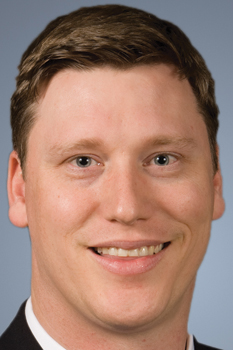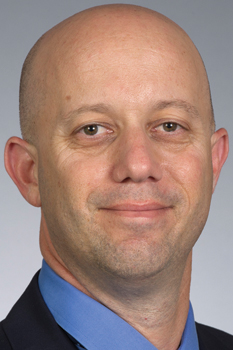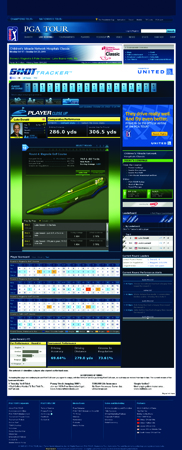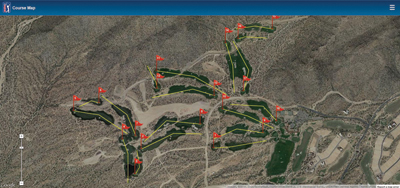Eight core members of the PGA Tour’s digital team gathered in an office for the big moment. At midnight on Dec. 21, the tour would transfer its entire digital operation from Turner’s control over to the tour’s own server.
The move represented the culmination of more than a year’s worth of work. An unopened bottle of 18-year-old scotch sat on a desk nearby, ready for the celebration.
The process was supposed to be simple — just a line of code and the switch would be flipped. They waited until midnight, when traffic on PGATour.com would be low, then Scott Gutterman, the tour’s senior director of digital operations, entered a code and hit the key.
 |
PGATour.com will undergo a significant redesign this year.
|
Nothing. He tried again. Nothing.
Two hours and 600 lines of code later, they found the problem: an out-of-place semi-colon. Damn semi-colons.
Finally, around 2 a.m., the switch was made and the tour’s digital operations were fully in their own hands. And it was time to open the bottle of scotch.
“The digital transfer was the biggest moment in my 12 years at the tour,” said Paul Johnson, senior vice president of PGA Tour new media. “It’s a milestone for the tour. This represents taking control of a very important strategic part of our business.”
The night of Dec. 21 represented the culmination of almost 18 months of deliberation, modeling, late-night meetings, missed birthdays, holidays cut short and a Valentine’s Day evening spent at the office.
But it also was just the start. Working with Omnigon, a systems integration firm in New York, the tour officially took control of its digital rights on Jan. 1. Now, two months later, the tour has launched three new digital products, including the highly anticipated simulcast of its TV broadcasts.
“It would have been nice if we could have just flipped the switch and then gone home,” said Luis Goicouria, the tour’s vice president of digital operations and business development. “Our work was just beginning. … The decision to bring the rights in-house was the hardest. It was the path of most resistance. But we all felt very strongly that digital was too strategic and too important for us not to own it.”
 |
JOHNSON
|
The tour has always outsourced its digital rights. First, CBS managed them and then, six years ago, Turner won the tour’s digital rights through 2012.
But by bringing those rights in-house, the tour will “control its own destiny,” Johnson said. Instead of simply collecting a check from Turner each year for a rights fee and a share of online sales, the PGA Tour now will determine its own digital — and financial — fate.
With that control comes the flexibility to create more products and sell across all
 |
| BUSHKELL |
of its platforms, generating potentially more revenue while also extending the tour’s brand by making its products available on any digital platform.
Johnson and Lee Bushkell, vice president of media sales, have added sales staff in New York, Chicago and Los Angeles to take advantage of the new structure. In all, 15 new positions have been created across operations and sales. The tour can now sell across PGATour.com, its inventory of mobile apps, advertising and sponsorship on network simulcasts, ad space on PGA Tour network on Sirius XM, and the tour’s weekly TV “Inside the PGA Tour” show on Golf Channel.
 |
GOICOURIA
|
“We’ve got a whole array of cross-platform opportunities now that are all tied nicely together,” Johnson said. “It’s better for our clients. We can tie in media, TV, digital, sponsorship, hospitality, all of the assets of the PGA Tour, and offer a customized package to sponsors.”
Bushkell said the tour previously drove those ad buyers to Turner, or a network partner like NBC/Golf Channel or CBS. Now the tour can put together robust and versatile sales packages like one it recently sold to 5-Hour Energy and
 |
GUTTERMAN
|
Florida-based attraction Discovery Cove, which are not title sponsors or official marketing partners, so they represent all new money.
The energy shot drink has a sponsorship and ad units in several video elements on PGATour.com to go with its TV advertising, while Discovery Cove will have geographically targeted ads that will run as the tour makes its Florida swing this month.
“The big change is that this opens up a whole new range of clients that we weren’t talking to before,” Bushkell said. “Advertisers in the past have always gone to one of our media partners before, but now we can offer several different ways to activate with the PGA Tour. People want to be able to talk to the league.”
Other deals that range from $250,000 to $500,000 a year combine video with radio, online and commercial production work by PGA Tour Entertainment.
“There is a significant amount of digital, but clients are finding value in the other offline assets we can bring to bear, such as radio or TV,” Bushkell said. “We also feature end-to-end production capabilities, which is valuable in many of our deals.”
 |
Developing popular products like Shot Tracker is a priority for the team.
|
In addition to the sales potential, the tour is beginning a rollout of products in 2013 that will elevate both PGATour.com and its mobile apps. The tour’s digital products include Shot Tracker, stats center, scoring, fantasy games, video archives and more to be determined. Those are the free products. The tour also is considering a premium line of products that could include different camera angles, featured holes or featured players.
In the last 30 days, the tour’s had three major product launches: a relaunch of portions of PGATour.com; the simulcasts; and an on-site mobile app for its tournaments.
“There’s going to be a lot more,” Goicouria said. “This is going to be a big year for product development.”
At some point, possibly later this year, the tour also will go through a full redesign of PGATour.com with Omnigon’s help.
By 2014, the tour’s entire digital offering will have, in some cases, an enhanced look, and in other cases a completely different look.
“We work with a lot of leagues and I wouldn’t say that technology has been an afterthought, but it hasn’t been a primary focus,” said Igor Ulis, co-founder and CEO of Omnigon, which worked with NASCAR on a similar process a year earlier, and counts Major League Baseball and the U.S. Tennis Association among its league clients.
“What you’re seeing now is that technology is playing a much more important role in the day-to-day operations of these leagues,” Ulis said. “The linear broadcast used to be the focus. Nowadays, leagues are looking to engage fans across every possible touch point. They understand that you have to sustain a level of engagement to remain relevant. That’s driving leagues to take control of their content across all forms of media.”
What that means financially remains to be seen, but Johnson is optimistic because the digital landscape is such a high-growth space. Without going into too much detail, Johnson said he expects a profitable first year for the digital division.
“The audience for digital has doubled in the last three years and revenue is close to three times what it was seven years ago,” he said. “We feel very good about” the business model.
 |
The PGA Tour’s live course maps show viewers where golfers are on the course.
|
The new in-house model involves paying a host of vendors, but it allows the tour to keep all of its revenue from sales and eventually a roster of premium products.
“With all of the consumption online and mobile, it has the potential to be a very lucrative business,” Ulis said. “Year over year, traffic levels are growing, so the eyeballs are there.”
The chronology of the tour’s digital move actually began in the summer of 2011 during its TV negotiations with CBS and NBC. That’s when the tour secured the rights to simulcast the network broadcasts on PGATour.com and other mobile outlets.
By February 2012, the tour’s digital team — led by Johnson and including Goicouria, Gutterman, Bushkell and systems analyst Andrew Chapman — were meeting every day to establish models for every possible scenario.
In the outsource model, they looked at staying with Turner or moving to CBS or NBC. For the in-house model, they looked at building their own data center and hiring as many as 55 people to run it, or hiring vendors and using their infrastructure. They eventually chose the vendor model.
On the night of Feb. 14, 2012, Valentine’s Day, the digital team worked late into the evening to prepare for one of their most pivotal presentations the next day. Their audience would be the PGA Tour’s leadership of Commissioner Tim Finchem, executive vice presidents Ty Votaw, Ed Moorhouse and Rick Anderson, and CMO Tom Wade.
“All the wives had to be very understanding of the process,” Goicouria said with a laugh.
All of the modeling and analysis was leading the tour to bring its rights in-house. Johnson talked often with NASCAR’s Marc Jenkins, who had a similar experience a year prior when NASCAR took its digital operation in-house, and Brian Rolapp, COO of NFL Media.
The final determination was made in the spring of 2012. Once the decision was made to bring the rights in-house, the tour selected Omnigon to be its systems integrator. Omnigon won the tour’s business over another systems integrator with a strong sports presence, Digitaria.
Essentially, Omnigon led the tour through the process over the next several months, the start of what will be a multiyear relationship. That included hiring about 20 vendors — companies that would assist the tour with everything from video players to ad operations and delivery, hosting, content delivery, fantasy games and mobile platforms, among others. Omnigon typically offered two to three candidates for a job, but left final decisions to the tour, Ulis said.
With all of that in place on the night of Dec. 21, the tour flipped the switch, took over its own digital operation and popped the top on the bottle of scotch.
In many ways, their work was just beginning on a new digital frontier, but there was a collective sigh of relief that at least one major stage had been crossed.
“Looking back, it was something that took years off my life, years off everyone’s life,” Johnson said with a laugh. “Once the transition was made and everything was OK, you could sense the tension level easing. But now it’s like, ‘OK, what’s next?’ There’s no going back now.”










